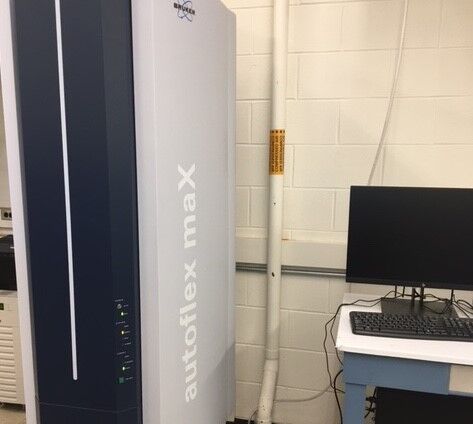Mass Spectrometry and Nuclear Magnetic Resonance
Cornell boasts several facilities housing mass spectrometry and nuclear magnetic resonance (NMR) instrumentation for trace element, molecular, and polymer analysis.
CCMR Operated Instruments:
Our polymer facility includes a Bruker Autoflex MALDI-TOF MS (Matrix-Assisted Laser Desorption/Ionization Time-of-Flight Mass Spectrometer) for identification of polymer chain masses via laser ablation. Additionally, solid or liquid samples can be separated and analyzed using our Waters Ambient Temperature Gel Permeation Chromatography (GPC) instruments.
Bruker Autoflex MALDI-TOF
Primary staff: Dimitrios Koumoulis
Location: ST Olin Laboratory B78
Specifications:
- Reflectron mode allows for enhanced resolution up to ~m/z 10 kDa for small molecules (generally above m/z 400 – 500), polymer end-group analyses, and small protein/peptide-sequencing studies
- Linear mode is used for larger molecules, offering decreased resolution, but enhanced sensitivity for larger polymers and proteins, up to over m/z 100 kDa
- 2 kHz Bruker SmartBeam II laser offers sample acquisition times of 0.5 – 2 seconds for most routine analyses
- Standard Bruker MTP 384 spot polished-steel target plate is required, and can be purchased from the Facility Manager at cost
For those studying synthetic polymers by MALDI, the NIST MALDI Recipes page is a great place to start for learning about MALDI sample preparation.
Waters Ambient Temperature GPCs
Primary staff: Dimitrios Koumoulis
Location: ST Olin B-78
Waters Ambient Temperature Aqueous GPC Specifications:
- Accommodates water-soluble and electrolyte-based polymers
- Separates polymers and oligomers in the molecular weight range of 100 D to 1,000,000 D
- Equipped with dual detection capability; UV and differential refractive index (dRI)
Waters Ambient Temperature THF GPC Specifications:
- Accommodates THF-soluble polymers
- Separates polymers and oligomers in the molecular weight range of 100 D to 1,000,000 D
- Determines composition and molecular weight of polymerization mixtures as well as block and random copolymers
- Equipped with triple-detection capability: a Waters 410 differential refractive index detector; a Waters 486 UV-Vis detector; and a Wyatt Technologies TREOS three-angle light-scattering detector which is useful for absolute molecular weight determination
Other Useful Facilities:
The Cornell Mass Spectrometry (CMaS) group specializes in trace element analysis, isotope ratios, and trace element mapping. They operate an ESI NWR193UC excimer laser and an Agilent 8900 Triple Quadrupole Inductively Coupled Plasma Mass Spectrometer (ICP-QQQ).
The Cornell NMR and Chemistry Mass Spectrometry Facilities operate several mass spectrometers and nuclear magnetic resonance (NMR) instruments. The NMR facility currently houses five high-field spectrometers ranging in field strength from 400 to 600 MHz, including two 500 MHz Brukers equipped with nitrogen-cooled Prodigy™ CryoProbes. The Chemistry MS facility specializes in the analysis of small, organic and organometallic analytes and has two available instruments, a Thermo Exactive GC-Orbitrap Gas Chromatography-Mass Spectrometry (GC-MS) system and a Thermo Exactive with a Direct Analysis in Real-Time (DART) ion source.
The Surface Analysis Facility at the University of Delaware has an IONTOF Time-of-Flight Secondary Ion Mass Spectrometry (TOF-SIMS) instrument. They accept samples for analysis by staff.


